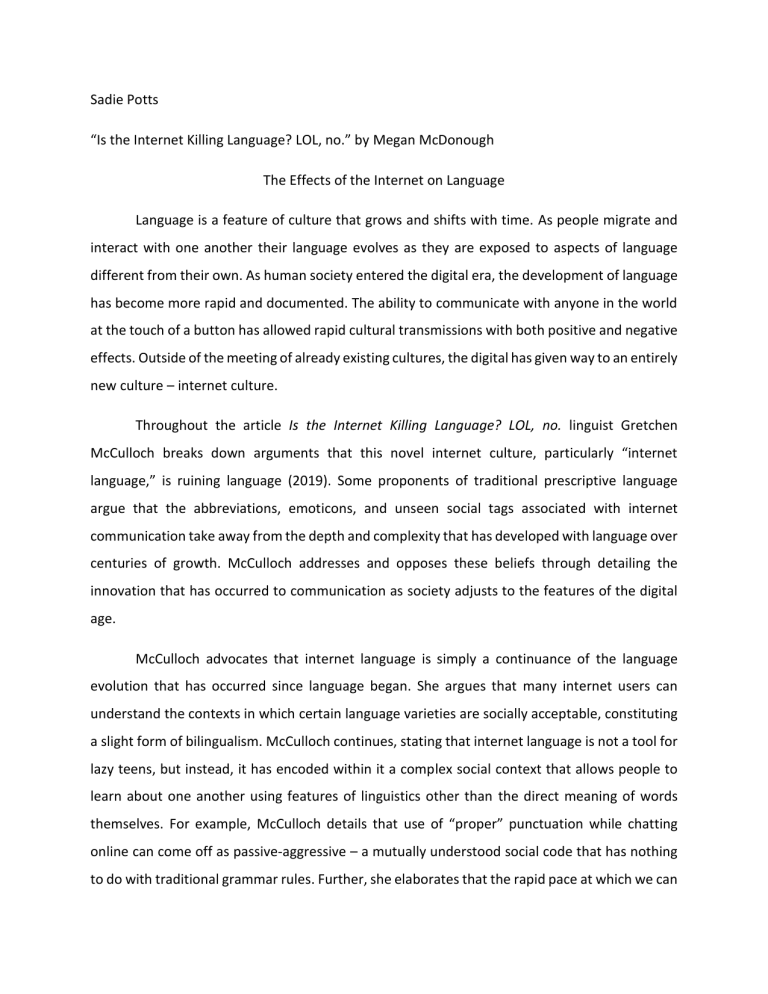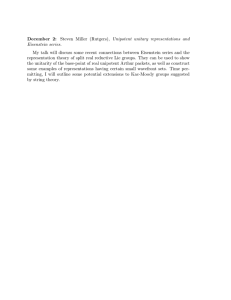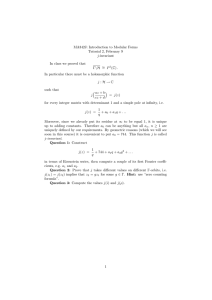
Sadie Potts “Is the Internet Killing Language? LOL, no.” by Megan McDonough The Effects of the Internet on Language Language is a feature of culture that grows and shifts with time. As people migrate and interact with one another their language evolves as they are exposed to aspects of language different from their own. As human society entered the digital era, the development of language has become more rapid and documented. The ability to communicate with anyone in the world at the touch of a button has allowed rapid cultural transmissions with both positive and negative effects. Outside of the meeting of already existing cultures, the digital has given way to an entirely new culture – internet culture. Throughout the article Is the Internet Killing Language? LOL, no. linguist Gretchen McCulloch breaks down arguments that this novel internet culture, particularly “internet language,” is ruining language (2019). Some proponents of traditional prescriptive language argue that the abbreviations, emoticons, and unseen social tags associated with internet communication take away from the depth and complexity that has developed with language over centuries of growth. McCulloch addresses and opposes these beliefs through detailing the innovation that has occurred to communication as society adjusts to the features of the digital age. McCulloch advocates that internet language is simply a continuance of the language evolution that has occurred since language began. She argues that many internet users can understand the contexts in which certain language varieties are socially acceptable, constituting a slight form of bilingualism. McCulloch continues, stating that internet language is not a tool for lazy teens, but instead, it has encoded within it a complex social context that allows people to learn about one another using features of linguistics other than the direct meaning of words themselves. For example, McCulloch details that use of “proper” punctuation while chatting online can come off as passive-aggressive – a mutually understood social code that has nothing to do with traditional grammar rules. Further, she elaborates that the rapid pace at which we can now communicate, along with the public nature of such communications, allows those who are mistreating or appropriating language to be easily identified and addressed. Overall, McCulloch thoroughly displays a multitude of ways through which the internet has advanced language rather than destroying it. Linguist Jacob Eisenstein touches on the phenomenon of internet language in his article, What to do about bad language on the internet (2013). Through the piece Eisenstein lists a variety of common reasons why people believe that internet language has come to exist, providing data and discussion around each topic. Eisenstein touches on illiteracy, length limits, text input affordances, and social variables each as a potential proponent for the development of the language that we see on the internet today. Eisenstein approaches the idea that illiteracy contributes to internet language by highlighting a study by Drouin and Davis in 2009 that found that individuals who were frequent users of internet language did not have significantly different literacy scores than those who do not use internet language. He further states that this data supports the idea that internet users maintain free will to choose when internet language is appropriate to them. Moving into a discussion of length limits, Eisenstein showcases that abbreviated text is not positively correlated with shorter length limits, and that the two are not correlated at all. This furthers the point that internet language is a choice, not an obligation. Text input affordances, most notably autocorrect, and the differences among them between brands of technology have taken some blame for the promotion and development of language on the internet. The effects of this are difficult to measure as input affordances vary greatly from user to user, however, Eisenstein points to the fact that technology like autocorrect directly inhibits some forms of internet slang. These forms include untraditional or shortened spellings and abbreviations that rapidly develop and may not be a part of the technological dictionary. Lastly, Eisenstein elaborates on the ways that social variables have affected and grown internet language. Rather than asserting that social dialects have infiltrated the internet, making it what it is, Eisenstein expresses that because of the influence of social variables on internet language, it is far more representative of the general population than standard language ever will be. Furthering his point, he details that journalism, an area where only standard language is used, is only filled by 7.5% minority writers, while twitter, a highly used social media app, supports a higher proportion of minority users than are represented in the population. Through these demonstrations, it becomes apparent just how much internet language is justified and has developed as a language in its own right – and how important it is to normalize it rather than reason away its existence. The internet has affected human society much beyond the development and expansion of human-to-human communication. As mankind progresses in its knowledge and understanding of the internet and the computers that use it, a new form of communication has arisen – computer-to-human communication. Over recent years, large language models (LLMs) have risen to popularity in the field of communication. LLMs are able to use information readily available on the public internet coupled with artificial intelligence to communicate on a variety of topics. One potential development of this form of internet communication is detailed by Anmol Arora in her article The promise of large language models in healthcare (2023). Through this piece, Arora details the potential development of this form of internet generated language into settings where human communication has become time consuming and somewhat mundane. Specifically, Arora discusses potential healthcare applications where LLMs would take on the task of writing hospital discharge letters and summarizing patients stays in terms that exclude medical jargon. These tasks can take healthcare providers hours each day, reducing the amount of time that they can spend face-to-face with patients. Through this proposed use, internet generated language would allot for increased human interaction between doctors and their patients. This system is not perfect, however. As it is in the early stages of development currently, researchers have encountered difficulty in allowing the model to learn about human disease, as health information is protected in the United States. Alongside this setback, the model itself has shown significant evidence of social biases that would not be acceptable in its use. While the technology of language models that the internet has afforded is fascinating and has promising potential applications, there is much optimization that needs to be done before LLMs will be able to replace human communication, either on the internet or face-to-face. The development of language both through the internet and on the internet are important topics to discuss. Morphology, phonology, semantics, and pragmatics are all important to language development. What makes internet language an interesting topic of discussion is its heavy reliance on the social aspects of language outside of these categories. Because internet language is adapted from a base language, it shares much morphology, phonology, etc. with that language, what sets it apart are social factors encoded in tactical use of an already known language. There is a great deal of understanding regarding context that is essential to effective use of internet language. Interpretation of linguistic context to successfully continue conversation, and situational context to allow development of the conversation outside of the immediate are both important linguistic factors of language beyond semantics. However, internet language places a strong emphasis on social context, making it physically visible through the style of writing. Through this system, it is possible to use simple aspects of language such as punctuation, capitalization, emoticon use, abbreviation style, and many more factors as social context to learn about others without ever seeing or meeting them. Internet users may even perform linguistic accommodation of these factors to be favorable communication partners, just as is often done in spoken conversation. Those who are versed in internet language are able to potentially collect information through these factors and develop an idea of how old someone is, what gender they are, or even whether they are likely to be compatible as friends. There are many fascinating additional features of communication on the internet that allow typed language to be just as informative, expressive, and personal as spoken language. It is important to note that this type of social learning through communication style can also be hurtful and discriminatory. Through her interview, Dr. McCulloch touches upon the topic of “columbusing” which she describes as the cultural appropriation of language on the internet. Because so much socio-cultural information is encoded within typed utterances alone, it can be very easy to use terminology or communication styles that may not be appropriate. Hurtful language or judgement based on language use or style is a large source of internet bullying and discrimination. Social codes in internet language can be used in exclusionary ways just as easily as they can be used in inclusionary ways, adding to the caution that one needs to take when using internet language. These factors demonstrate just how complex human language is, whether it is written, spoken, or typed. Language can evolve and grow at rapid speeds that can make it difficult for some to adjust, particularly to the introduction and popularity of internet language. However, the rapid rise to popularity and fluency in internet language has demonstrated that people do not need to be taught language. Of course, formal training in language is very helpful in gaining fluency, but there is a large portion of language and communication that just cannot be taught. Users of internet language did not attend a course on the effects of internet punctuation, rather they experienced internet punctuation, the way it made them feel, and the way it made others feel, and they learned from it. They developed their own ideas about what is acceptable and what is not, and they implemented these ideas into their internet communication moving forward. Human language is everchanging, and humans are ever-learning, meaning that organic human development in language is never-ending. Works Cited Arora, A. (2023). The promise of large language models in health care. The Lancet, 401(10377), 641. https://doi.org/10.1016/s0140-6736(23)00216-7 Drouin, M., & Davis, C. (2009). R U txting? is the use of text speak hurting your literacy? Journal of Literacy Research, 41(1), 46–67. https://doi.org/10.1080/10862960802695131 Eisenstein, J. (2013, June). What to do about bad language on the internet. Atlanta, Georgia; School of Interactive Computing, Georgia Institute of Technology, from https://aclanthology.org/N13-1037.pdf McDonough, M. (2019, July 22). Is the internet killing language? LOL, no. Vox. Retrieved April 10, 2023, from https://www.vox.com/the-highlight/2019/7/22/20702335/internet-language-textemojis-gifs-bad-for-english




